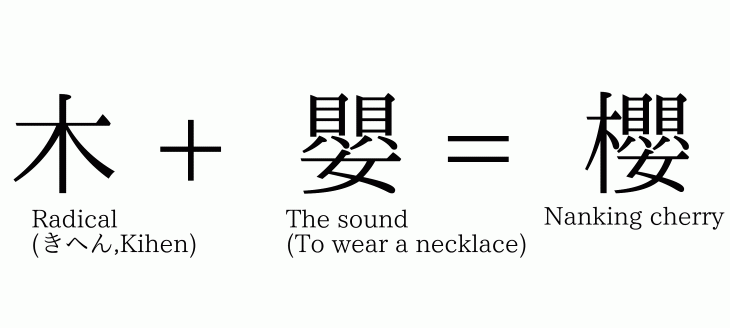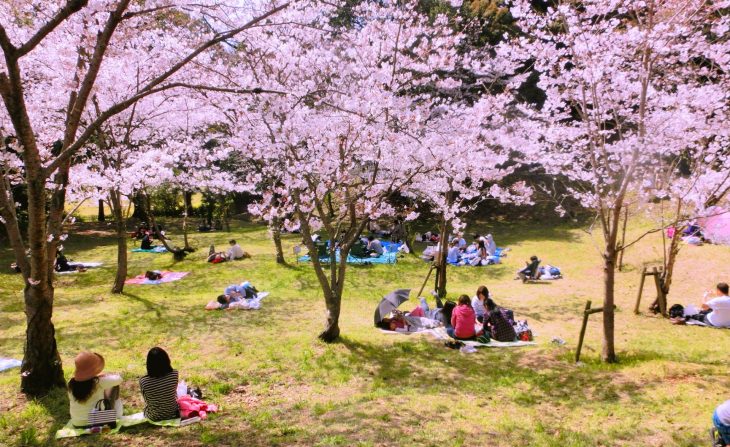Share this link via
Or copy link
One of the best Japanese Kanji dictionary.

Kanji for cherry blossoms is 「桜」 and is pronounced “Sakura.” Cherry blossoms grow wild in a wide area in the temperate zones in the northern hemisphere, not just in Japan. However, the flower has always been special to Japanese people and has a strong relationship with Japanese culture valuing impermanence. Some say that Sakura is the national flower of Japan, although not officially recognized by the government.
In this article, let’s see the relationship between Sakura and Japan.
Contents
桜 means “cherry blossoms,” but they are for ornamental use and don’t produce any fruit. If you say just “桜,” it usually refers only to the flowers. If you want to talk about the tree of cherry blossoms, you should say “桜の木”(Sakura no ki). Many varieties are included in the concept, and the one most frequently seen in Japan is ソメイヨシノ “Somei Yoshino cherry.”

Somei Yoshino
There are other varieties such as 山桜(or ヤマザクラin Katakana, pronounced “Yamazakura”), 八重桜(Yaezakura, double cherry), and so on. 吉野(Yoshino) in 奈良(Nara) prefecture is a very famous spot for Yamazakura.

Yamazakura at Yoshino
What is confusing is that although 桜 means “cherry blossoms” in English, it doesn’t bear cherry, which is called さくらんぼ(sakuranbo) in Japanese. The names are similar and quite confusing in both English and Japanese. Cherry blossom trees and cherry trees are in the same group of plants, but their varieties are different.
The character of 桜, which used to be written 櫻, initially didn’t mean “cherry blossom.” It meant “Nanking cherry,” a different variety of tree.

Origin of Sakura
木 means “tree,” and when it becomes a radical, it is used for the characters representing many kinds of trees, parts of trees, things made of wood, and the status of trees.
嬰 means “to wear a necklace,” therefore, the character 櫻initially meant Nanking cherry, which bears fruits that look like gems of a necklace.
In Japan, 櫻 is only used for people’s names today, especially family names such as 櫻井(Sakurai).

Ohanami
Japanese people love to see cherry blossoms blooming every year. The extremely significant point of cherry blossoms is that the flowers only bloom for a very short time, usually for about a week. Also, they easily fall off by wind or rain. If they last longer, Japanese people would not precious cherry blossoms as they do now.
お花見  (Ohanami) or 花見(Hanami) literally mean “viewing flowers.” It is like a picnic under cherry blossoms. People gather and enjoy food or drinks together. Some people just enjoy wandering around the row of cherry blossom trees. It could be taken place either during the daytime or at night. The cherry blossoms seen at night are called 夜桜
(Ohanami) or 花見(Hanami) literally mean “viewing flowers.” It is like a picnic under cherry blossoms. People gather and enjoy food or drinks together. Some people just enjoy wandering around the row of cherry blossom trees. It could be taken place either during the daytime or at night. The cherry blossoms seen at night are called 夜桜  (Yozakura), a Kanji component of 夜(yoru, meaning “night”) and 桜. 夜桜 are often illuminated and look fantastic.
(Yozakura), a Kanji component of 夜(yoru, meaning “night”) and 桜. 夜桜 are often illuminated and look fantastic.

Yozakura
When spring comes, the weather forecast in news programs on TV starts reporting the estimates when they will bloom. Cherry blossoms begin to bloom from warmer regions; therefore, the flowering season entirely differs by the province. The problem is that, even in the same area, it varies by the year too. It depends on the temperature of that year.
There is a word 「桜前線」, a combination of 桜and 前線(zensen) meaning “weather front.” People stick to the news of 桜前線 and carefully see when the cherry blossoms start to bloom in their region to plan when to go out for お花見.

Image of Sakura Zensen
Cherry blossoms are also beautiful when they are blown by the wind. Their petals dance in the air. This phenomenon is called 桜吹雪  (Sakurafubuki), a word made by 桜 and 吹雪(Fubuki) meaning blizzard.
(Sakurafubuki), a word made by 桜 and 吹雪(Fubuki) meaning blizzard.
Please watch this video and see how fantastic it is.
歓声あがる上野公園桜吹雪、美しい日本の風景。Beautiful Japanese scenery, Cherry blossoms blizzard in Ueno Park.
桜 is also used for the name of a color. 桜色  (Sakurairo) means cherry blossom color, which is associated with the color of the flowers.
(Sakurairo) means cherry blossom color, which is associated with the color of the flowers.
桜餅  (Sakuramochi), literally meaning “cherry blossom rice cake,” is a pink rice cake filled with sweet red bean paste, wrapped in a pickled cherry blossom leaf. The leaf tastes salty, not sour. It is a seasonal sweet during the flowering season.
(Sakuramochi), literally meaning “cherry blossom rice cake,” is a pink rice cake filled with sweet red bean paste, wrapped in a pickled cherry blossom leaf. The leaf tastes salty, not sour. It is a seasonal sweet during the flowering season.

Sakura mochi
This kind of tiny shrimps in the picture below is called 桜エビ  (sakuraebi), literally meaning cherry blossom shrimp. It is called “Sakura shrimp” in English as well. You can buy the dried ones at a supermarket.
(sakuraebi), literally meaning cherry blossom shrimp. It is called “Sakura shrimp” in English as well. You can buy the dried ones at a supermarket.

Sakuraebi
Somehow, horse meat is called 「桜肉」 (Sakuraniku).「肉」(niku) means meat.
(Sakuraniku).「肉」(niku) means meat.
It is often served in sashimi style, and the dish is called 「馬刺し」 (Basashi). Kyushu region is famous for the dish. You might be able to find it in some of the 居酒屋
(Basashi). Kyushu region is famous for the dish. You might be able to find it in some of the 居酒屋  (Izakaya, Japanese-style pub) in the other areas too, but I suggest you search for an 居酒屋 specialized in Kyushu cuisine because most of those 居酒屋 have 馬刺し on their menu.
(Izakaya, Japanese-style pub) in the other areas too, but I suggest you search for an 居酒屋 specialized in Kyushu cuisine because most of those 居酒屋 have 馬刺し on their menu.

Basashi is usually served with grated garlic and grated ginger.
There are several theories about why horse meat came to be called 桜肉. One of them says that it is because the color of the fresh meat just after opening with a knife looks 桜色. Another says that “horses eat much in winter, therefore they taste delicious with a lot of fat in spring.”
As explained above, it isn’t easy to forecast when the cherry blossoms start to bloom, and they last for about only a week. Unless you are a person who could go on a trip whenever you want and buy a flight ticket as soon as you get the news that they started to bloom, it isn’t easy to see them blooming in Japan during a short visit. If you were able to see it, you’re lucky!
There is a famous Waka(one of the styles in ancient Japanese poetry)
「世の中にたえて桜のなかりせば 春の心はのどけからまし」
(Yononakani taete sakura no nakariseba haru no kokoro wa nodokekaramashi) written by Ariwara no Narihira in the ninth century.
It means that “If cherry blossoms don’t exist at all, I could stay calmer during springtime.” People are very excited about when the cherry blossoms start to bloom and worry when they will fall off. From this poem, we could see that Japanese people have appreciated the transient beauty of Sakura from more than 1000 years ago.
What is Onyomi?
Onyomi, also known as the "Sino-Japanese reading," is one of the two main reading systems for kanji characters in Japanese. It refers to the reading of a kanji character that is derived from the original Chinese pronunciation.
What is Kunyomi?
Kunyomi, also known as the "native Japanese reading," is one of the two main reading systems for kanji characters in Japanese. It refers to the reading of a kanji character that is based on the native Japanese pronunciation. Kunyomi readings are often used when a kanji character stands alone or is followed by hiragana, as in verbs and adjectives. Mastering both kunyomi and onyomi is crucial for understanding and using kanji effectively in the Japanese language.
What is Radical?
A radical, also known as "bushu" in Japanese, is a fundamental component of kanji characters. Radicals are the building blocks of kanji and are used to categorize and organize them in dictionaries. There are 214 traditional radicals, each with its own meaning, which often provides a clue to the meaning of the kanji character it forms.
What is strokes?
Stroke count, or "kakusuu" in Japanese, refers to the number of individual brushstrokes required to write a kanji character. Each kanji has a specific stroke order and stroke count, which are essential for writing the character correctly and legibly. Understanding and following the correct stroke order not only ensures proper balance and aesthetics but also makes writing more efficient and fluid.